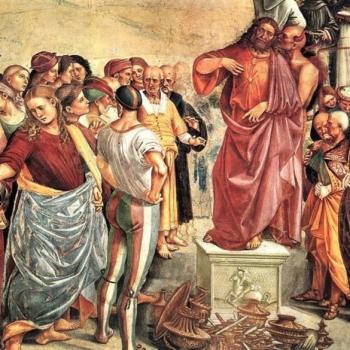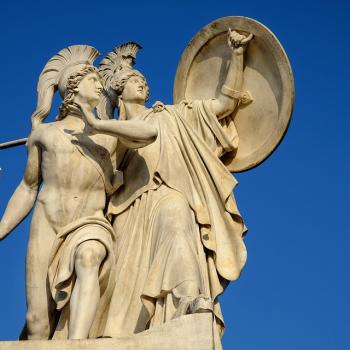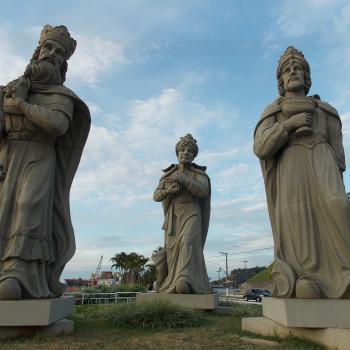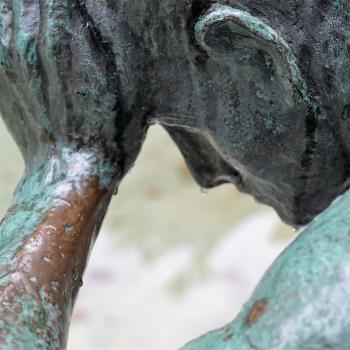We’ve come to Anatolios’ conclusion, a chapter rich with ideas and summaries. I could have drawn this out for several more posts, but I became quite “Julian” in my threeness, wanting the series to have twenty-seven posts, no more, no less.
So let’s oh-so-briefly look at the final comments Anatolios makes that might suggest ways of moving into “a creative retrieval of Nicene Trinitarian faith.”
Revelation
In the glorious Trinity, we recognize a God who has revealed himself – who wants to be known. We see a God who, though completely other than the created world, wants to be in relationship with it. The burden is not on us. We cannot “generate” knowledge of God; only God can make himself known. How? Through reading scripture with the lens of the “ecclesial communion” and responding in worship and discipleship. This is all joy—joy now in the growing “knowledge and love and union with the divine,” and joy ahead, the “consummation of this process” in the perfect completion of what we will be and the fullness of love when we “see him as he is” (1 Jn. 3.2).
Mulhern Coda: As so many of our Christian mystics remind us, knowing God is all about being known and loved by him. To see him, to really behold the Lord, is to receive his vision of himself.
Scripture
Scripture discloses the Triune One—it’s not a systematic theology or doctrinal guidebook. While we approach scripture most holistically through the lens of the conversations and interpretations of the Church, we must engage them as proclamation, not merely as a source of facts about God. This means, according to Anatolios, that we really explore the riches of the Church’s teaching about the original scriptural idioms. As he asks, “How often does one hear Jesus referred to in homilies as Word, Wisdom, Image of the Father? Yet, as we have seen, these scriptural characterizations were crucial to the formulation and appropriation of the dogma that he is homoousios with the Father.” There is so much more to understand about the Christ, and so many rich, unexplored ways to understand his Personhood. And, Anatolios points out, this “broad scriptural spectrum” of naming—seen in scripture and underscored by the early Church fathers, can help us in the very real concerns about the constant masculine imagery—Father-Son—that may be so close-ended for some today.
Mulhern Coda: Because we so often adopt a posture of defensive aggression—both with those who have no faith and, most sadly, with those who share our faith—we strip down our message to the most elementary truths about Jesus and his Christos identity. Jesus saves. Well, yes he does. Follow Jesus. Well, most certainly. Accept Jesus into your heart. Done. Jesus is God’s Son. Absolutely.
But what about the brilliance and depth and majesty of the Triune relationship, into which we are invited? Yes, I understand that this is not standard evangelistic fare, but I suspect we have diluted our message to the point that people think that “the line in the sand which must be crossed” is the extent of the gospel. What, then, does the author of Hebrews mean when he writes, “Therefore let us leave the elementary teachings about Christ and go on to maturity…” (Heb. 6.1)?
Tradition and Ecclesial Scriptural Interpretation
Big heading here, but really key thought. The question is: What is the relationship between scripture, doctrine, and tradition? These early Church councils and the conversations that surrounded them are deeply relevant to this monstrous question. Anatolios points out Athanasius’ guidelines. They include:
a) the “sufficiency” of scripture. While there is plenty of room for misinterpretation, we also have to insist that all critical Christian teaching “arises from the Scriptures and cannot essentially represent elements extraneous to Scripture.”
b) the authority to define which doctrinal interpretations of scripture are the correct ones is that of the Church, the worshiping community, not the individual. (Anatolios points out that, by saying this, he is not saying that “the mere occurrence of a council” guarantees anything; just that the “ecclesial witness” is necessary.)
c) the worshiping community is obligated to demonstrate the ways that scriptural truth is always in continuity with its transmission through time. That is, even the community is obligated to trace the articulation of the faith back through the ages of the community and show its general congruity with the ways scripture has always been interpreted through the ages.
Mulhern Coda: There is a word of rebuke in this section for both Protestant and Roman Catholic and Orthodox traditions. The first—Protestants—love point (a). Yeah, take that! The Roman Catholic and Orthodox underscore point (b). Try the Church on for size!! There are oh-so-many doctrines/beliefs/systems/formula ON BOTH SIDES of the ecclesial divide that are essentially incompatible with one or more of Anatolios’ points. If you need me to point some of them out, feel free to email me. Otherwise, let’s just pause here and examine our souls. If there’s anything we learn from our journey through this era of Church history, it is the ways that scripture and Church need each other.
Worship
Trinitarian spirituality (Anatolios teaches us the word eusebeia, or piety) is Christocentric. It is in worshiping Jesus Christ that we affirm the Trinitarian relationships and the Trinity’s work on our behalf. This is expressed most elementarily and fully in the act of baptism. We clearly recognize that the early Fathers saw baptism not as human proclamation but as divine incorporation “into the life of the Triune God [deification].” It is our baptism that gives meaning and power to our communing with God in the Eucharist. Anatolios: “Participation in the interrelations of Father, Son, and Spirit is simultaneously the goal and the means of Christian sacramental life.”
Mulhern Coda: Worship. If there’s anything I have taken away from my study of Anatolios’ work, it is the centrality of worship: life-giving, communal, formative, empowering, divine-infused. When I think of the very early church services, when the unbaptized were dismissed after the proclamation of the word, so that the baptized community could worship God through the celebration of the Eucharist, it begins to make a perverse kind of sense. Hardly seeker-friendly, I realize. Yet, if we really suppose that there is a divine-human communion in worship that is fully expressed in the Lord’s Supper and our shared faith and commitment through baptism, well, our church services might be falling a mite short of the real thing.
The Primacy of Christ
“A Nicene interpretation of Scripture necessarily involves a maximal affirmation of the primacy of Christ. . . . Christian faith is essentially faith in the lordship of Christ, and this premise is the first principle of Christian discourse.” (Anatolios) This drives the fullness of the conversation throughout the 4th century: how do we understand the nature of this person, Jesus Christ, and what does his life among us tell us about God? The Arian answer—in myriad forms and patterns—was that the lordship of Christ was one derived from his perfection as God’s creature. The Nicene answer—hammered out sometimes with finesse and sometimes rather roughly—was that this “perfection as God’s creature” attitude was simply inadequate. Yes, perfect creature in his humanity; but also perfect God in his divinity: a “double primacy of Christ.”
Even more than this, Anatolios argues, is what the humility and subjection of the Christ in his human life tells us about God. Some might interpret the kenosis of the Son as a sign of a “lower level of precedence with respect to the Father,” and the Son’s sending of the Spirit as indicative of the Son’s higher status to the Spirit—such that we have “graded levels of ontological precedence.” This is to conflate the economic Trinity with the immanent Trinity, which Anatolios addresses much earlier in the book, and we talked about in Trinitarian Spirituality, 3. This would give us a God in descending order of glory. But this, Anatolios points out, is to diminish the identity of the Son and Spirit. The Nicene argument is to stress the gorgeous truth that Christ’s self-emptying is indeed not a sign of his subjective status within the Godhead, but indeed indicative of divine perfection itself. Christ’s humbling tells us the truth about the nature of God: compassionate, self-sacrificial, tender toward humanity.
Mulhern Coda: In our all conversations about God, our experience of his presence, our deepest held values and practices (justice, compassion, evangelism, creation-care, etc.), primacy of place is reserved to Jesus Christ. That is, none of the rest of it comes first. Indeed, considering Anatolios’ clear description of the self-giving nature of God—revealed most perfectly in the life, death, and resurrection of Jesus Christ—it is clearly impossible to do any good works that embody his Spirit unless we do so out of the central proclamation: Jesus is Lord.
The Person of the Holy Spirit
The Holy Spirit “is the one in whom the relation between the Father and the Son is extended outward.” As we name Jesus Lord, we are experiencing the Spirit, who enables us to cling to that primacy. The incarnation is an arena of “co-activity” of Son and Spirit, working together to draw us back to God; the Son becoming the nexus of engagement—as God, giving the Spirit; as human, receiving the Spirit. As we receive the Spirit, we take on the form of Christ. “In the economy of salvation, Jesus gives us the Spirit and the Spirit gives us Jesus as Lord and we are thus enfolded into the circle of mutual Trinitarian glorification.”
Mulhern Coda: Here I find a sweetness and a secret joy that somehow I missed out on in all my Church experience. We indeed have neglected the Spirit, and have failed to see the Spirit’s work in our words and actions. Anatolios draws on the teachings of the fathers in recognizing the work of the Spirit in integrating us, through Christ, into the Fellowship of the Three, and I am overcome.
Creation
The wrestling in the early Church over the radical otherness of God over against creation provoked many of the “nature of Christ” statements. Human, yes…then on the creation side? God, however, “unbegotten” and therefore on the transcendent side? The beauty of the Nicene synthesis is to see the Son’s eternal generation from the Father as an inherent sign of his transcendence, and his birth as a human baby as his act of divine descent. Within the Godhead, there is such mutual love and mutual delight, according to Anatolios, that this pours itself out in creation—not of necessity, but out of purpose and will. The Spirit, the “giveable God,” makes that intra-divine love and delight accessible to us through creation.
Mulhern Coda: Creation is the arena in and through which God wishes to reveal himself. In creating, in preserving, in pursuing; in hallowing, in participating, in wooing—the Father, the Son, and the Spirit have made all creation, and all its creatures, great and small, their delight. We recognize that, being made in his image, we are appointed as his stewards. This does not give us carte blanche with God’s world. We are not given creation to plunder, but to hone and tend in such ways that every little part of it gives glory to God.
Christian Salvation
It’s time, according to Anatolios, to return to the early theologies of the church that “typically understand the essential content of Christian salvation in terms of a fairly maximal conception of union with God, which can be designated by the term ‘deification.’”
Wow.
This is so far afield from what my evangelical roots would have described. And Anatolios, I think, knows it. He writes, “This soteriological conception can be distinguished from others in which salvation is conceived not so much in terms of union and ‘joining’ but of becoming adept at knowledge and worship of God and obedience to the divine will.”
That’s what I pretty much thought salvation was: knowing the truth about God (correct doctrine) and submitting to God’s will (obedience). This double action of belief (leading to justification) and obedience (evident in sanctification) then leads to salvation—a renewed life and a heavenly life. Anatolios is not saying that these are not still critically important, but what he does say is that such a notion of salvation does not actually require the full and perfect divinity of the Son and Spirit. When, in contrast, we really look carefully at the engagement of the human and the Spirit within the person of Jesus Christ, we begin to see that salvation is about being adopted by grace into that God-Man, and thus moving in and through him into the Trinitarian communion.
Mulhern Coda: “Are you saved? Do you know where you’ll go if you died today?” Not bad questions, but so, well, so unimaginative somehow. Anatolios has drawn for me a vision of a new kind of relationship with God, one that has far more wonder, glory, and unadulterated joy than “going to heaven when I die.” (Don’t take me wrong. I’m counting on heaven.) We are invited here to receive an invitation into the eternal Fellowship of the Three, to “trip the light fantastic” as we grow ceaselessly in the love and knowledge of the One who has no limits. Now and forever.
Humanity in the Image of the Trinity
Anatolios reviews the ancients’ assumptions that humanity displays some divine image. We can think about this with the “psychological analogy” (memory, knowledge, and will) or using the “social analogy” (Lover, Beloved, Love), and yet both of these only are “signs.” Ultimately, the image within us is so deeply broken that we can only yearn for the fullness as we continue to pursue oneness with God in Christ. Nevertheless, the fact that the Lord has made us worthy to bear his image and to grow increasingly into the likeness of Christ and share in his divine life means that the relationships of love that echo that of the Three—particularly marriage, parenting, and friendship—should be honored.
Mulhern Coda: There is an awful lot in life I have not done well. I am weak, wrong, hardhearted, and fearful. And yet, the love I have for and in my family—parents, spouse, children, siblings—draws back the veil, just a little, and shows me something of what truly is, and what will be.
Divine Being as Trinity
And so we come to the end, reiterating the wonder that is the Trinity, and recognizing that God not only interacts with us in revelation as Trinity, but that this revelation is in fact the truth of God’s being. “Trinitarian faith is ultimately the project of allowing ourselves to be determined by God’s Trinitarian being.” It isn’t about having better answers, but about clarifying our understanding of what we have received and making that the fuel of our flame of love toward God.
Mulhern Coda: As my coda here, I adopt Augustine’s prayer as my own. This is the whole point of this exploration, the end of all our desiring:
Directing my attention toward this rule of faith as best I could, as far as you enabled me to, I have sought you and desired to see intellectually what I have believed. . . . Do you yourself give me the strength to seek, having caused yourself to be found and having given me the hope of finding you more and more. . . . Let me remember you, let me understand you, let me love you. Increase these things in me until you refashion me entirely.
Congratulations. We’ve finished Anatolios’ book! What a feast it has been. Thank you for taking the mystagogical journey with me. Tune in next week for the start of something new…
___________________________
Note to Reader: This series on Trinitarian Spirituality explores the history and spirituality behind the shaping of the Nicene Creed using Khaled Anatolios’ Retrieving Nicaea: The Development and Meaning of Trinitarian Doctrine (Grand Rapids, MI: Baker Academic, 2011) as guide and inspiration. It’s best to begin at the beginning: An Introduction.
















